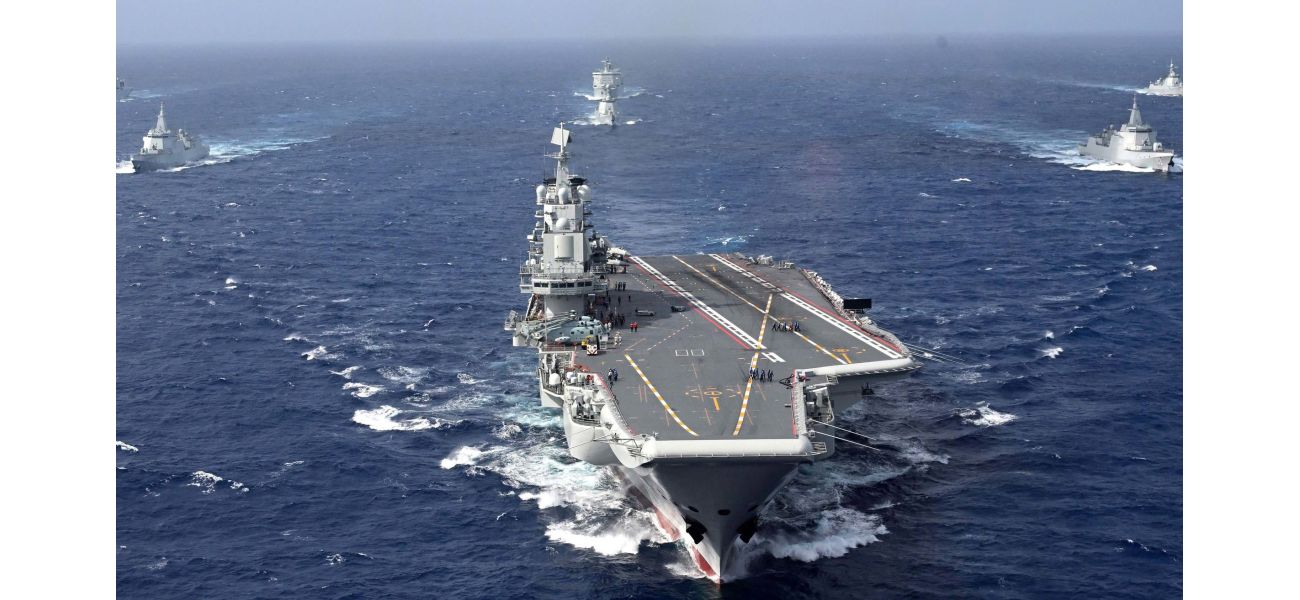China has constructed a prototype nuclear reactor for their aircraft carrier, a recent study shows.
China has constructed a prototype nuclear reactor for a big warship on land.
November 12th 2024.

China is advancing its plans for a nuclear-powered aircraft carrier, according to recent analysis of satellite imagery and Chinese government documents. This development marks a significant step forward in China's efforts to modernize its navy and become a top global power.
The project, known as the Longwei or "Dragon Might" Project, is being constructed in the mountains of Mucheng township in the southwest Chinese province of Sichuan. This location was initially suspected to be the site of a reactor for weapons production, but it has been confirmed that it is actually a prototype reactor for a large warship.
The decision to pursue a nuclear-powered carrier is a clear indication of China's determination to achieve a true "blue-water" force capable of operating far from its shores. With the world's largest navy, China has been rapidly modernizing its military in an effort to challenge the United States' global dominance.
Experts believe that adding nuclear-powered carriers to its fleet would place China among the ranks of the world's most powerful naval forces, currently only occupied by the United States and France. For China's leadership, this development would not only boost national prestige but also fuel domestic nationalism and elevate the country's global image as a leading power.
The research team at the Middlebury Institute of International Studies in California made this groundbreaking discovery while investigating a mountain site outside of the city of Leshan. Through satellite imagery and public documents, they were able to identify the prototype reactor and confirm China's pursuit of a nuclear-powered aircraft carrier.
While rumours of China's plans to build a nuclear-powered carrier have been circulating for some time, this is the first concrete evidence that they are actively working on a nuclear propulsion system for a carrier-sized warship. According to Jeffrey Lewis, a professor at Middlebury and one of the researchers on the project, operating a nuclear-powered carrier is an exclusive club that China looks set to join.
The satellite images and public documents also revealed the involvement of China's Defence Ministry and Foreign Affairs Ministry in the project. Contracts for steam generators and turbine pumps, as well as an environmental impact report, all point towards the development of a pressurized water reactor with a secondary circuit, a profile consistent with naval propulsion reactors.
The team's 19-page report, which was shared exclusively with The Associated Press, provides a detailed analysis of their findings. They were able to confirm that the reactor at Leshan is a prototype for a next-generation aircraft carrier and is expected to become operational soon. It is housed at Base 909, which is under the control of the Nuclear Power Institute of China and currently houses six other operational, decommissioned, or under construction reactors.
The research does not, however, provide any indication of when China's nuclear-powered carrier could be built and become operational. Experts agree that the evidence presented by the Middlebury team is a compelling case for China's pursuit of a nuclear propulsion system for its naval surface ships. This development marks a significant step forward in China's pursuit of a powerful and modern navy, further challenging the United States' global dominance.
China has built a prototype nuclear reactor for a large surface warship, according to new analysis of satellite imagery and Chinese government documents. This development signals that China is moving closer towards producing its first nuclear-powered aircraft carrier, a significant step in its efforts to become a major naval power.
China's navy is already the world's largest by number, and its modernization efforts have been rapid. However, the addition of nuclear-powered carriers to its fleet would be a significant achievement, allowing China to project its military power farther from its shores and pose a challenge to the United States' dominance in the global seas.
Tong Zhao, a senior fellow at the Carnegie Endowment for International Peace, believes that having nuclear-powered carriers would elevate China's status as a first-class naval power, a privilege currently held by only the United States and France. This development would also be seen as a symbol of national prestige and fuel domestic nationalism, bolstering China's image as a leading global power.
Researchers from the Middlebury Institute of International Studies in California discovered the prototype reactor while investigating a mountain site near the city of Leshan in China's Sichuan province. They had initially suspected that China was developing a reactor for producing weapons-grade plutonium or tritium, but their findings confirmed that the reactor was intended for a large warship.
The project, known as the Longwei or Dragon Might Project, is also referred to as the Nuclear Power Development Project in official documents. However, neither China's Defence Ministry nor Foreign Affairs Ministry provided any comment on the matter.
The Middlebury team's research is the first to confirm that China is working on a nuclear-powered propulsion system for a carrier-sized surface warship. According to Jeffrey Lewis, a professor at Middlebury and one of the researchers involved, operating a nuclear-powered aircraft carrier is an exclusive club that China is now poised to join.
Using satellite images and public documents, the researchers were able to identify the location of the reactor project in the mountains of Mucheng township, about 112 kilometers from Sichuan's provincial capital, Chengdu. The site, known as Base 909, is controlled by the Nuclear Power Institute of China, a subsidiary of the China National Nuclear Corporation responsible for reactor engineering research and testing.
The researchers also uncovered procurement documents indicating that China's 701 Institute, which is responsible for aircraft carrier development, had acquired reactor equipment for a large surface warship under the Nuclear Power Development Project. This, along with other evidence, led to the conclusion that the reactor at Leshan is a prototype for a next-generation aircraft carrier.
Satellite images from 2020 to 2023 showed the demolition of homes and the construction of water intake infrastructure at the reactor site. Additionally, contracts for steam generators and turbine pumps suggest that the project involves a pressurized water reactor with a secondary circuit, a configuration commonly used in naval propulsion systems.
An environmental impact report classified the Longwei Project as a secret national defense-related construction project. According to the researchers, this information, along with the location and evidence of construction activity, strongly suggests that China is developing a nuclear-powered aircraft carrier.
Experts who reviewed the findings, such as Jamie Withorne from the Oslo Nuclear Project and Sarah Laderman from Open Nuclear Network, were convinced by the evidence presented and believe that China is working towards building a nuclear-powered propulsion system for its naval surface ships at the Leshan site.
While the research does not provide any indication of when a Chinese nuclear-powered carrier could become operational, it is a clear indication of China's pursuit of this goal. In the future, such a development could significantly shift the balance of power in the global naval landscape.
The project, known as the Longwei or "Dragon Might" Project, is being constructed in the mountains of Mucheng township in the southwest Chinese province of Sichuan. This location was initially suspected to be the site of a reactor for weapons production, but it has been confirmed that it is actually a prototype reactor for a large warship.
The decision to pursue a nuclear-powered carrier is a clear indication of China's determination to achieve a true "blue-water" force capable of operating far from its shores. With the world's largest navy, China has been rapidly modernizing its military in an effort to challenge the United States' global dominance.
Experts believe that adding nuclear-powered carriers to its fleet would place China among the ranks of the world's most powerful naval forces, currently only occupied by the United States and France. For China's leadership, this development would not only boost national prestige but also fuel domestic nationalism and elevate the country's global image as a leading power.
The research team at the Middlebury Institute of International Studies in California made this groundbreaking discovery while investigating a mountain site outside of the city of Leshan. Through satellite imagery and public documents, they were able to identify the prototype reactor and confirm China's pursuit of a nuclear-powered aircraft carrier.
While rumours of China's plans to build a nuclear-powered carrier have been circulating for some time, this is the first concrete evidence that they are actively working on a nuclear propulsion system for a carrier-sized warship. According to Jeffrey Lewis, a professor at Middlebury and one of the researchers on the project, operating a nuclear-powered carrier is an exclusive club that China looks set to join.
The satellite images and public documents also revealed the involvement of China's Defence Ministry and Foreign Affairs Ministry in the project. Contracts for steam generators and turbine pumps, as well as an environmental impact report, all point towards the development of a pressurized water reactor with a secondary circuit, a profile consistent with naval propulsion reactors.
The team's 19-page report, which was shared exclusively with The Associated Press, provides a detailed analysis of their findings. They were able to confirm that the reactor at Leshan is a prototype for a next-generation aircraft carrier and is expected to become operational soon. It is housed at Base 909, which is under the control of the Nuclear Power Institute of China and currently houses six other operational, decommissioned, or under construction reactors.
The research does not, however, provide any indication of when China's nuclear-powered carrier could be built and become operational. Experts agree that the evidence presented by the Middlebury team is a compelling case for China's pursuit of a nuclear propulsion system for its naval surface ships. This development marks a significant step forward in China's pursuit of a powerful and modern navy, further challenging the United States' global dominance.
China has built a prototype nuclear reactor for a large surface warship, according to new analysis of satellite imagery and Chinese government documents. This development signals that China is moving closer towards producing its first nuclear-powered aircraft carrier, a significant step in its efforts to become a major naval power.
China's navy is already the world's largest by number, and its modernization efforts have been rapid. However, the addition of nuclear-powered carriers to its fleet would be a significant achievement, allowing China to project its military power farther from its shores and pose a challenge to the United States' dominance in the global seas.
Tong Zhao, a senior fellow at the Carnegie Endowment for International Peace, believes that having nuclear-powered carriers would elevate China's status as a first-class naval power, a privilege currently held by only the United States and France. This development would also be seen as a symbol of national prestige and fuel domestic nationalism, bolstering China's image as a leading global power.
Researchers from the Middlebury Institute of International Studies in California discovered the prototype reactor while investigating a mountain site near the city of Leshan in China's Sichuan province. They had initially suspected that China was developing a reactor for producing weapons-grade plutonium or tritium, but their findings confirmed that the reactor was intended for a large warship.
The project, known as the Longwei or Dragon Might Project, is also referred to as the Nuclear Power Development Project in official documents. However, neither China's Defence Ministry nor Foreign Affairs Ministry provided any comment on the matter.
The Middlebury team's research is the first to confirm that China is working on a nuclear-powered propulsion system for a carrier-sized surface warship. According to Jeffrey Lewis, a professor at Middlebury and one of the researchers involved, operating a nuclear-powered aircraft carrier is an exclusive club that China is now poised to join.
Using satellite images and public documents, the researchers were able to identify the location of the reactor project in the mountains of Mucheng township, about 112 kilometers from Sichuan's provincial capital, Chengdu. The site, known as Base 909, is controlled by the Nuclear Power Institute of China, a subsidiary of the China National Nuclear Corporation responsible for reactor engineering research and testing.
The researchers also uncovered procurement documents indicating that China's 701 Institute, which is responsible for aircraft carrier development, had acquired reactor equipment for a large surface warship under the Nuclear Power Development Project. This, along with other evidence, led to the conclusion that the reactor at Leshan is a prototype for a next-generation aircraft carrier.
Satellite images from 2020 to 2023 showed the demolition of homes and the construction of water intake infrastructure at the reactor site. Additionally, contracts for steam generators and turbine pumps suggest that the project involves a pressurized water reactor with a secondary circuit, a configuration commonly used in naval propulsion systems.
An environmental impact report classified the Longwei Project as a secret national defense-related construction project. According to the researchers, this information, along with the location and evidence of construction activity, strongly suggests that China is developing a nuclear-powered aircraft carrier.
Experts who reviewed the findings, such as Jamie Withorne from the Oslo Nuclear Project and Sarah Laderman from Open Nuclear Network, were convinced by the evidence presented and believe that China is working towards building a nuclear-powered propulsion system for its naval surface ships at the Leshan site.
While the research does not provide any indication of when a Chinese nuclear-powered carrier could become operational, it is a clear indication of China's pursuit of this goal. In the future, such a development could significantly shift the balance of power in the global naval landscape.
[This article has been trending online recently and has been generated with AI. Your feed is customized.]
[Generative AI is experimental.]
0
0
Submit Comment





